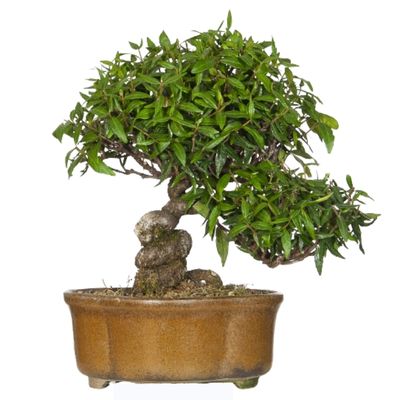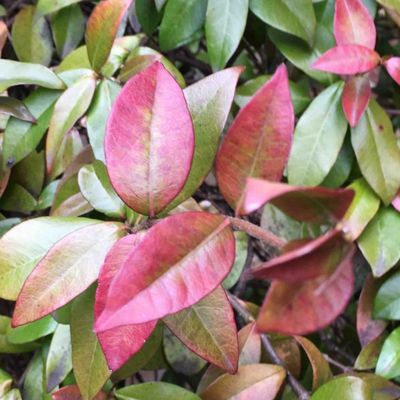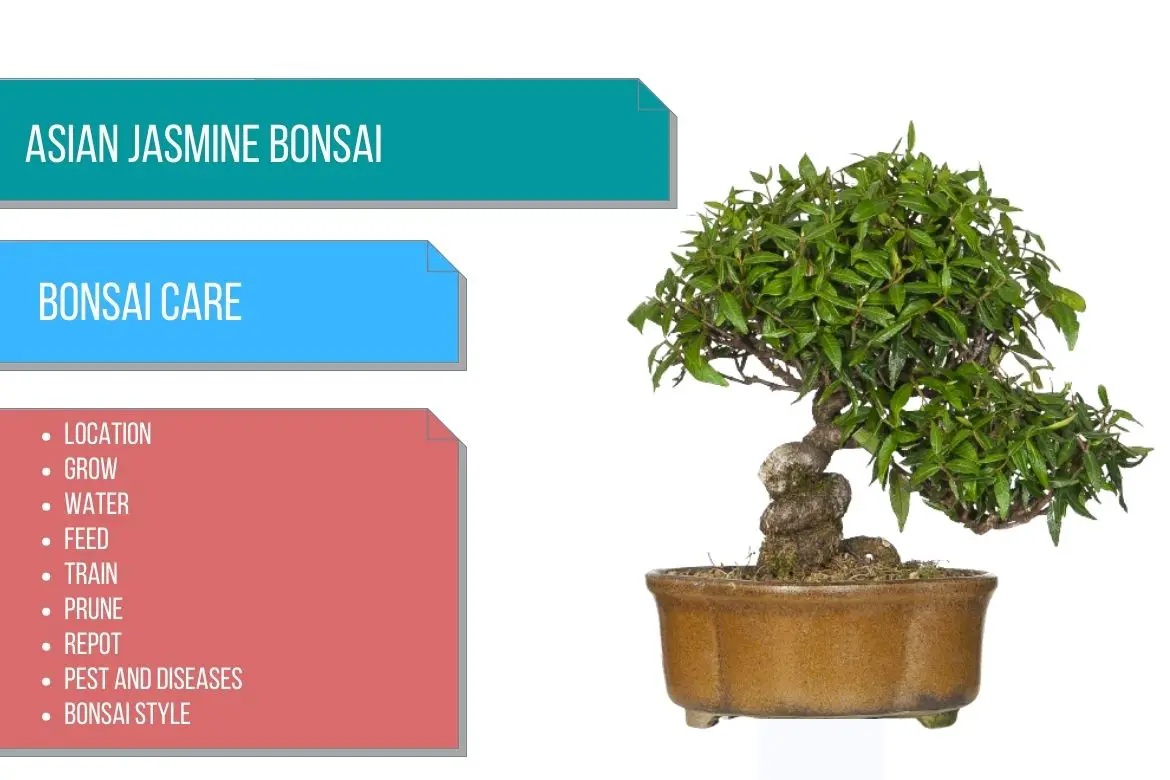
Asian Jasmine / Asiatic Jasmine / Chinese jasmine / Asian star Jasmine
(Trachelospermum asiaticum)
Country of Origin : Southern China and Japan
Bonsai Styles : Informal upright, cascade, semi-cascade
Zone : 7 – 11
The Asian jasmine tree is an evergreen tree. Beginners will find it easy to work with, making it a good starter bonsai.
This plant has oval, glossy, dark green leaves that are approximately 1 to 2 inches long.
There are pale yellow blooms that appear only on mature Trachelospermum asiaticum bonsai specimens, which are highly fragrant and are very small in size.
The tree has a slow and dense growth habit. Asian star Jasmine is primarily grown as a bonsai for its brilliant leaves, that change in color from medium green to red, yellow, orange and “rusty” color. The best display of colors can be seen in fall season.
Asian Jasmine is a vine and has a tendency of climbing walls. Hence, naturally it has a thin trunk and wiry stems. A twining trunk can give an illusion of a thick trunk.
Because of its think trunk, mostly mature Asian jasmine bonsai trees end up in cascade bonsai style.
You can make a small or a fairly large Asian star Jasmine bonsai tree. large bonsai will also look good as it will look proportional to its large leaves. Air for a height of 16-20 inches (40 – 50 cms).
This tree also makes for a great indoor bonsai tree.

Summer brings abundant clusters of sweet scented, creamy flowers, which measure 3/4 of an inch (2 cm) in length. These flowers age to yellow over time.
This bloom only happens in mature bonsai trees.

By the end of the growing season, some of the foliage of the tree will turn red in color.
Best location to keep Asian Jasmine Bonsai
The Asian jasmine bonsai tree prefers full sun. However, it also does well in partial shade. Its a very robust plant that is able to easily adapt to full sun.
In the growing season, an ideal temperature range for the tree to do well is 70°F to 85°F (21°C to 29°C).
This bonsai prefers cool winters in indoor settings. The preferred temperature in winter can be 55°F to 65°F (12°C to 18°C).
A good location for keeping this bonsai tree in the house can be a sunny south or north facing window or a windowsill.
However, make sure that this window is not opened in winter. Protect the tree from cold winds.
Refer sunlight requirements for indoor plants for more indoor gardening ideas. Also, refer to do bonsai trees need sunlight for more indoor and outdoor bonsai location ideas.
Propagation of Asian Jasmine
Asian jasmine tree can be propagated through cutting and air layering.
Take softwood cuttings (about 6 inches long). Apply some rooting hormone and plant it in a small container. Keep the container in a bright location receiving indirect sunlight.
The cuttings will develop roots in about a month.
Watering Asian Jasmine Bonsai
Asian Jasmin tree is fairly drought tolerant when it matures. However, when grown in containers, one should make sure to maintain a good watering routine.
The thick leaves of this plant will give you the impression that this plant will need a lot of water. However, that is not the case. On the contrary, these plants dislike too much moisture. Therefore, do not overwater this bonsai.
You do not need to keep the soil moist. But water the tree when the soil feels dry to the touch.
Depending on your environment, water more in summer season and in winter reduce the amount of water.
Avoid watering the tree from above, as because of water droplets on the tree, direct sun can scorch the leaves.
Read watering bonsai tree for more details.
Wiring Asian Jasmine Bonsai
As Asian jasmine is a vine, it makes for a gorgeous cascade style bonsai.
However, if you are planning to have an upright bonsai tree, the tree will have to be stacked and wired accordingly. This will help in developing a strong trunk thick enough to support the foliage. (The trunk will be twisted).
This plant has an erratic growth pattern and it does not hold its shape easily, but it is quite pliable nonetheless.
In the beginning, wires are set to achieve the initial shape, but after one year, they are removed.
It is recommended to let the bonsai rest for six months before rewiring it.
Pruning Asian Jasmine Bonsai
When to prune Asian Jasmine bonsai?
How to prune Asian Jasmine bonsai?
It is important that you prune this vine hard when you train the bonsai in a cascade style in order to encourage a lot of branching.
However, if you want to have an upright style, you need to prune back hard in order to build a strong trunk.
It is best to prune the flowers while the plant is still young and in its developing phase.
The mature bonsai specimens should be pruned in spring or early summer after they have finished flowering.
Pinching Asian Jasmine Bonsai
Maintain the shape of the mature bonsai by pinching back new growth to two sets of leaves at a time.
Repotting Asian Jasmine Bonsai
When to repot Asian Jasmine bonsai?
Asiatic jasmine bonsai tree can be repotted every 2 years in spring.
The roots of the tree have a tendency to spread wide. You can prune the roots at the time of repotting. However, make sure not to prune them too aggressively.
I would recommend pruning the roots about half an inch all the way around.
You can use a basic free-draining bonsai soil mix as a potting soil.
OR
You can also use a soil mix consisting of 30% grit and 70% organic matter.
OR
You can also use a mix of peat (or compost), sharp sand and loam in the ratio of 1:1:2.
Must Read: Bonsai Soil Recipes
Must read : Choosing the right bonsai container
Feeding Asian Jasmine Bonsai
You should fertilize your bonsai tree weekly with a balanced fertilizer that is half strength.
The frequency should be reduced to once every two to three weeks during the winter months.
The soil should be supplemented once a month with an acidic fertilizer at half strength. Or apply a soil acidifier.
Read more about bonsai fertilizer and its application.
Diseases and pest of Asian Jasmine Bonsai
Generally these plants are pretty disease resistant. However, In few cases, these trees can be effected by aphids, scaled insects, spider mites and white flies.
It is possible to remove aphids by handpicking. Spray the leaves to clean them and use a systemic insecticide if the problem persists.
Tortoise wax scale will cause discoloration leaves and stem. This will cause honeydew or sooty mold.
Brown tea root disease will cause the leaves to fall from the tree. The leaves will wilt, become yellow and eventually die. The root cortex will also rot. use an appropriate fungicide.
If the plants are kept in an environment that is insufficiently humid, red spider mites will be present.
Additionally, plants that don’t have good air circulation (especially indoors) will develop mildew. Make sure the air is well ventilated.
Asian Jasmine bonsai care
It is absolutely necessary to have a free draining bonsai soil. or else the roots will rot quite easily.
Keep the tree protected from frost.

